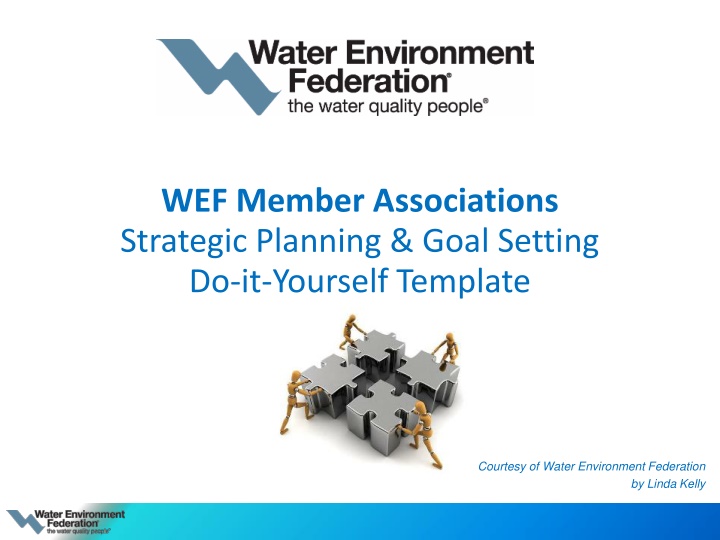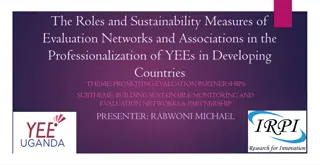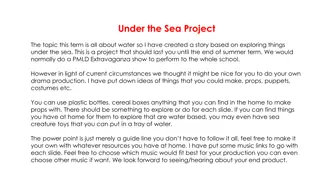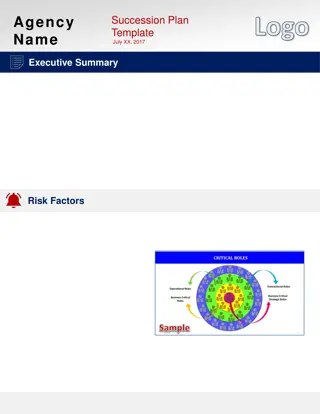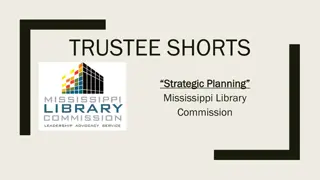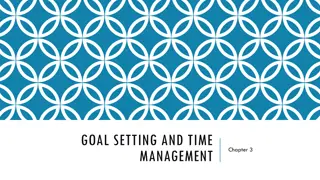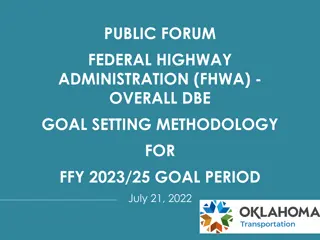DIY Strategic Planning & Goal Setting Template for WEF Member Associations
Create a comprehensive strategic plan for WEF Member Associations using this do-it-yourself template. Gain agreement on member engagement levels, define vision and goals, conduct SWOT analysis, and implement SMART attributes for objectives. Utilize a strategic planning facilitator, involve a diverse team, and establish regular meetings for successful completion within 6 months to 1 year. Assumptions, success factors, and tools are provided to guide the process and ensure alignment and effectiveness in association planning and implementation.
Download Presentation

Please find below an Image/Link to download the presentation.
The content on the website is provided AS IS for your information and personal use only. It may not be sold, licensed, or shared on other websites without obtaining consent from the author.If you encounter any issues during the download, it is possible that the publisher has removed the file from their server.
You are allowed to download the files provided on this website for personal or commercial use, subject to the condition that they are used lawfully. All files are the property of their respective owners.
The content on the website is provided AS IS for your information and personal use only. It may not be sold, licensed, or shared on other websites without obtaining consent from the author.
E N D
Presentation Transcript
WEF Member Associations Strategic Planning & Goal Setting Do-it-Yourself Template Courtesy of Water Environment Federation by Linda Kelly
Objectives Have agreement on the process and level of member engagement Have a common understanding of the definitions of vision, mission, values, strategies, goals, objectives, performance measures, action plans Have agreement on the time span for the strategic plan Have agreement of our MA s strengths, weaknesses, opportunities, threats (SWOT Analysis) Develop our vision/mission/values, goals and objectives using (SMART attributes)
Suggestions for Process Utilize someone familiar with strategic planning to facilitate doesn t necessarily have to be a third party, but primary role should be the process and not participation Use a smaller group/team (9-11) of diverse members to do the assessment, then report back to the larger group Set regular meetings (monthly) and a reasonable timeframe to complete (6 months 1 year)
Assumptions as a launching point The MA Board is interested in being a more strategic, deliberate and forward looking Association Need X-X year useful and living strategic plan to guide priorities and activities Need an inclusive process developed in a collaborative manner with input from key stakeholders Need data about our membership needs/expectations, the competition, the trends, etc. Need Board to take ownership of the plan and embrace a willingness to implement Need clear understanding of objectives and action plans Need clear, simple process for measuring performance
Getting on the Same Page Some important success factors for our work plan: You have the power to chart the course for this organization This is hard work; worth the effort Work from the same definitions/vocabulary so we don t get tripped up during the process Just start/do it. Stay with it. Get smarter as you go. Goal-setting/measuring critical, but don t let it consume you Given your volunteer and money resources, focus on being realistic in your goal-setting; understanding you likely can t be all things to all people
A Tool to Help Assess Association Status STRENGTHS (that will enable us) What skills do we have among our leaders? What advantages do we have due to people, processes, technology? What do we do better than others? What do others perceive as our strengths? What can we focus on that would be difficult for a competitor to replicate? WEAKNESSES (to overcome) What essential skills, technologies, processes are missing? What advantages do competitors have due to people, processes, technology? What obstacles must the strategy overcome? Consider how competitors will respond as you implement your strategy. OPPORTUNITIES (to grasp for success) What trends or conditions may positively impact WCWEA? What opportunities are available to you? What can you offer your members you haven t been? THREATS (that could derail strategy) What trends or conditions may negatively impact WCWEA? What are competitors doing that may impact us? Do we have a solid financial base?
SWOT ANALYSIS -- US SJWP EXAMPLE STRENGTHS Recent increase in prize from $3,000 to $10,000 Uniquely established as only water science research competition Experienced staff project manager Member Association Involvement willingness to judge, pay for student airfare, host national event WEF financial / leadership support Reputation/high quality/high standards established WEAKNESSES Lack of competitive strength to other STEM related competitions Reliability/lack of data re impact Strategic plan and goals/measures revised in 2012 less than aggressive Teacher involvement in US event discontinued Number of student entries remained much the same for many years** OPPORTUNITIES Potential opportunity for members and other individuals to contribute on line via a donate now button on website Newly created sponsorship tiered structure New model for hosting national at university Social Media promotion and networking Partnerships teacher associations, research institutions THREATS Economic conditions in past few years have reduced opportunities for corporate sponsorships Sustainable financial support/costs substantial MA expenses have challenged some to balk at funding More difficult each year to keep high profile at WEFTEC Opening General Session due to higher profile initiatives/time constraints
STRENGTHS (that will enable us) WEAKNESSES (to overcome) A Tool to Help Assess Association Status OPPORTUNITIES (to grasp for success) THREATS (that could derail strategy)
Working From the Same Definitions There are many words commonly used in Strategic Planning
Where we need to be in the future Vision Why we exist Mission What we believe Standards of conduct Values How it fits together Things we must do Goals How/when we will do them Objectives Monitoring success Measures
Our Starting Point - Values Values Brainstorming (What we believe; standards of conduct)
Values Example (Example courtesy of Rocky Mountain WEA) Core Values are what support our vision and mission; they shape our culture, and reflect who RMWEA is and how we operate Vision Statement is what RMWEA aspires to be; it helps drive decisions, focus goals, and is our overarching purpose in everything we do Mission Statement is our "purpose in action"; it's what we do every day to achieve our vision with direction from our values Vision
Our Starting Point - Vision Vision Brainstorming (where we need to be in the future key words that should be in our Vision)
Our Starting Point - Mission Mission (why we exist)
Definition of Strategic Goals & Objectives Strategic Intention is a few header words summarizing intent of goals (what we want to accomplish) Goals are about what we want to accomplish Objectives Describes how that change will be accomplished Usually 3-5 years in scope Basic types: Generic (i.e. growth, expansion/retraction, new products/services - adding translation) Competitive (owning our product -- more value/better price)
Definition of Strategic Goals & Objectives Strategic Intentions are about what we want to accomplish Strategic Objective (Critical Objective) Goal Strategic Objective (Goal) Objective Goal Objective
Goals and Objectives: Whats the Difference? Goals are broad; objectives are narrow Goals are general intentions; objectives are precise Goals are intangible; objectives are tangible Goals are abstract; objectives are concrete Example: Goal: To boldly go where no man has gone before. Objective: Explore the Planet Tatooine by June 2017, within the budget of $20M Galactic Credits.
Step 1: List Topics for Strategic Intentions & Goals Brainstorm the topic areas for the strategic intentions & goals (look to mission, existing intentions/goals and SWOT analysis for ideas) Group like topics Prioritize top 5 (but keep track of next 5)
Step 2: Strategic Intentions & Goals Agree on top X Priority Strategic Intentions Agree on top X Priority Goals
Step 3: From your general goals, create specific objectives under each one (consider the SMART attributes as you develop the specific objectives) Specific: clear, concise ( who, what, when, where, why and how)? Goal: To make WEF Highlights the most effective and efficient member communication channel. SMART Attributes Measurable: descriptively measurable? Achievable: can it be done given resources/time? Objective: Increase Highlights average monthly readership by 10% between Jan. 1 and July 30, 2014. Relevant: aligned with WEF mission/strategies/goals? Time-Bound: deadline for completion?
When thinking of SMART Objectives: Specific Bad Example: Increase participation of members. Good Example: Increase attendance at annual conference by XX. Measurable Bad Example: More members will attend Good Example: 80% of members will attend annual conference. Attainable Bad Example: 100% of members will attend every meeting. Good Example: Increase attendance at annual conference by 10% from the prior year. Relevant Bad Example: Teach all members to make a great pizza. Good Example: Ensure the highest quality water reuse training is available to members by xxx. Time-Oriented Bad Example: Winter Good Example: January 30, 2017
Step 3: Developing Specific Objectives under Broad Goals Break into X groups and develop a draft Objective for each assigned goal (keeping them SMART ) 1. Choose a facilitator 2. Choose a spokesperson to report out 3. XX minutes to develop 4. Spokespeople report out 5. Group to agree on objectives
Review of what we accomplished thus far Thoughts about the Process? Thoughts about the Vision? Thoughts about the Mission? Thoughts about the Values? Thoughts about the Strategic Intentions? Thoughts about the Priority Goals? Thoughts about the Objectives under the goals?
Step 4: Setting the performance measure Metrics: methods by which we measure success (or lack thereof) Quantitative: Predictive Statistics/numbers (time, costs, profit, percentage, etc.) Examples: website clicks, cost to serve, 27% increase Qualitative: Typically non-numerical, less precise, behavioral, may be answered by yes or no Measured through surveys, observing, insights Examples: customer experience, quality of the event, were you proud of it
Step 4: Putting it all together Use a tool to fill in the blanks with your newly developed vision, mission, values, strategic objectives, goals, objectives Add performance metrics and action plans
Putting it all together a format XXX XXXX Water Environment Association LOGO Strategic Plan - Work Plan date Vision slkdjflkdjlkgjlksjdlkgjlksdjlgkjslskjglksjdglkjsldkg Mission Lksdjfldkjfldkjflskjflksdjflksflksjflksjlf ;slkdfjlskdfjlskdjflksjflksjld Core Values Sldjfdkljflkdsjlkfjl Sdlfkjslkfdjlsdk Lskdfjdks Lskdfjlskdjfksjf Lsdkflksjdlsjf
Putting it all together a format EXAMPLE: Strategic Objective: Member Value Goals Objectives Action Plans & Metrics Leader Goal #X: Facilitate Knowledge Exchange Objective Xa: Successfully implement technical training - XXX seminar - June XX, 2017 with 120 attendees and a member evaluation that rates the program 4-5 (with 5 being excellent) Strategic Objective: XXX Goals Objectives Action Plans & Metrics Leader Goal #X: XXXX Objective Xa: XXXXX
Next Steps On-going Board duties: Continuous improvement Assigning roles (or champions) to begin implementation Continuous reporting/checking in until it becomes routine and on schedule Planning to roll out to the membership/communication Get back together for progress reporting and realignment regularly
